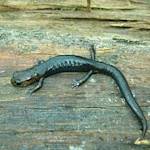Cape Verde Giant Skink
Extinct circa 1940 CE • Branco Island, Raso Island, Cape Verde
"The last known specimens of the 'Lagaro', as it was called by the Cape Verde fishermen, were captives in German collections around 1914, but the islanders claim that it did not finally die out in the wild until about 1940. It had long been prized as a source of meat by visiting fishermen and suffered especially from human persecution in 1833 when, during a famine, a group of 30 convicts were put ashore on Branco and left to fend for themselves. The main cuase of the Giant Skink's extinction, however, seems to have been severe droughts and consequent vegetation loss and soil erosion."
David Day, The Encyclopedia of Vanished Species (Hong Kong: Mclaren Pub., 1989).
Image: Barbosa Du Bocage, The Extinct Cape Verde Giant Skink (Chioninia Coctei). Digital image. Depiction from 'C. França: Le Professeur Barbosa Du Bocage. Boletim Da Sociedade Portuguesa De Ciências Naturais, Vol. 2, Pp. 141-194, 1908', 1908. Web.


Learn about Maya Lin’s fifth and final memorial: a multi-platform science based artwork that presents an ecological history of our world - past, present, and future.

Discover ecological histories and stories of former abundance, loss, and recovery on the map of memory.

Learn how we can reduce our emissions and protect and restore species and habitats – around the world.

See how art can help us rethink the problems we face, and give us hope that each one of us can make a difference.

Help make a global memorial something personal and close to home. Share your stories of the natural world.


